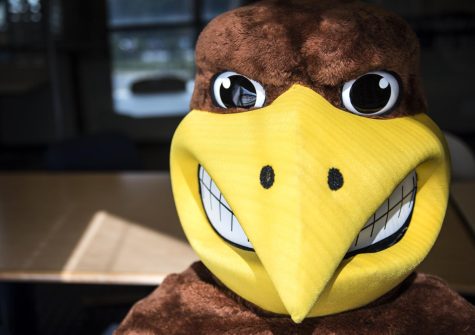Documenting Life in an Untouched Environment
January 29, 2014
Dean Horton was paddling in a kayak on a river when he saw tree-covered shores give way to waves crashing in the ocean. He looked around and scanned the densely forested mountains. Rocks lined the shore, pocketing life between them.
“It’s a utopia, essentially,” said Horton, a biology graduate student. “It’s shocking to see what an untouched world looks like.”
Matt Petrunak, senior electronic media production major, used the same word, “untouched,” to describe the same location, called Campanario, on the Pacific coast of Costa Rica.
A group of Kent State biology students travel to Costa Rica every other winter to study plant and animal life there. For the first time, however, a class of electronic media production students traveled with them this December and January to document their work and to collect footage of the environment.
The story of how Kent State film and biology students ended up spending three weeks together in the tropics goes back decades — before any of them were born.
Oscar Rocha grew up in Costa Rica. He studied and taught biology at the University of Costa Rica and conducted research in natural reserves there. Rocha later studied and taught at Penn State, where he earned his doctorate in ecology. In 1992, he took a group of biology students to Costa Rica on a study abroad trip. He did this for years and now does the same thing here at Kent State.
In 1973, David Smeltzer was a junior at Duke University majoring in biology. He told his dad he had an opportunity to study abroad in Belize and Guatemala. His dad said if Smeltzer bought a camera, he would buy the film. So he bought a wind-up camera, his dad made good on his promise, and Smeltzer took the equipment to Central America with him.
“I knew nothing about filmmaking at the time,” said Smeltzer, who later enrolled in film school and went on to create science educational films. He is now a professor of electronic media production at Kent State.
In his new class, titled “Science Documentary Film,” students are creating individual documentaries about conservation and ecology using footage from the Costa Rica trip.
“I think it’s an important subject matter that they will have as part of their portfolio that shows that they’re doing a real story about a real subject as opposed to a class project,” Smeltzer said. “And let’s face it, it’s a gorgeous opportunity to do some gorgeous shots.”
The students traveled to four biological stations — Palo Verde, a dry forest; San Ramon, a cloud forest; La Selva, a lowland forest and Campanario, which included forest and ocean environments. They spent four to five days at each location.
Four groups consisted of four biology students, who conducted experiments, and two film students, who documented it all. A separate group of two film students alternated taking scenic shots and conducting interviews with the directors of the biological stations.
In Campanario, the film students pitched ideas for their 10-to-20-minute documentaries that they will work on for the rest of the semester. They are able to use their own footage as well as their classmates’.
Smeltzer said the students will give a presentation of the documentaries at the end of the semester, which might take the form of a public viewing in the FirstEnergy Auditorium in Franklin Hall. The documentaries might also be posted on the Kent State School of Journalism and Mass Communication’s website.
Ashley Lain, a senior dance major minoring in electronic media production, said her documentary is about how the four biological stations deal with conservation.
“The common link among all of them is they’re linked to national parks, and Costa Rica’s government is really good about protecting the environment,” she said.
Smeltzer said nearly everything in Costa Rica was recycled or reused. It wasn’t like in Ohio “where you have junkyards with just dead cars.”
Petrunak’s documentary is focused on amphibians and reptiles and how deforestation, urbanization and plantations have affected them. He said he already had an interest in amphibians and reptiles, but an on-site lecture about the creatures spoke to his interests.
“They weren’t so much geared toward the film students, which was a little rough,” Lain said of the biology lectures. Neil Golias, a junior electronic media production major, said the speakers kept talking about p-values, which most of the film students didn’t understand.
View Kent State students study in Costa Rica in a larger map
Rocha said it is important that journalists and filmmakers translate scientific jargon and relay information to the public because even the most basic research can be useful.
“When people started working with DNA, just isolating DNA and looking at it, looking at the structure, that led to work for all the biotechnology that we have today, fingerprinting, potential medications. All those things came from a very basic study that started 50 years ago,” he said.
Rocha said his students conducted a total of 12 experiments on the trip. One involved looking at wasps and where they placed their nests.
Horton, a teaching assistant, took part in three experiments. In Palo Verde, he studied a specific kind of ant, called antlions, and the prey traps they built. In San Ramon, he studied the relationship between bees and orchids. In La Selva, he studied tent-making bats.
Golias filmed Horton’s group in Palo Verde and leafcutter and bullet ants in La Selva. After deciding to make his documentary a children’s show about ants, he went to film army ants in Campanario.
He also filmed scenery in the San Ramon cloud forest, where water flowed throughout the area.
“You’re just crisscrossing the flowing spring water everywhere,” Golias said.
A river in San Ramon hydroelectrically powered the biological station, whereas the other three stations were solarpowered. The solar power caused problems for the film students because they were often unable to charge their camera batteries at night, Smeltzer said.
Those weren’t the only adjustment issues. Golias said the water pipes were narrow and the students had to throw away their toilet paper rather than flushing it.
“It was interesting and very different to be in a place where everywhere you go you have to think about how much water you’re using, what you’re drinking, how much electricity you can use and what you’re eating,” Petrunak said.
Golias said he took the food at home for granted.
“I lost five pounds,” Smeltzer said. “I ate really well — vegetables, beans and rice, a little meat. Came back, ate greasy food — my stomach went ‘aurghhh,’ but I ate it anyway.”
Having to carry heavy camera equipment up mountains was rigorous, Lain said, but it was worth it.
The biological factors are incredibly diverse in Costa Rica, Rocha said. For example, there are 1,500 species of orchids and 112 species of bats.
The students got to see exotic animals in their natural habitats, like toucans, monkeys, sloths, crocodiles, peccaries, iguanas, scorpions, tarantulas, dolphins, whales and sea turtles.
Then there was a snake, the deadly fer-de-lance, which they continually had to walk past outside the Campanario cabin. Golias said if the snake bites you, there’s a good chance that “it’s going to tear off your flesh and destroy your muscle.”
Smeltzer said the people at the station roped off the area and said they were going to kill it, but maybe it overheard the conspiracy — it slithered away and the group was able to keep working in peace.
Contact Patrick Williams at [email protected]























